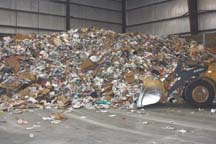Midwest Fiber is sorting and baling 10,000 tons of reusable materials each month from recycled waste
By Carl Roberts, EAC Volunteer
Recycling is reducing landfill waste by 40 percent
When central Illinois residents and businesses set aside their recyclable waste, they are taking an active role in cutting the landfill space needed for storage of garbage and trash by nearly one half. As space for landfills is becoming exceedingly scarce, recycling as much waste as possible is critical for the preservation of Illinois’ farmland and cities.
Where does the recyclable waste in curbside containers go?
Trucks from the city of Bloomington drive house-to-house and pick up recyclable waste left in curbside containers every two weeks. Trucks from the town of Normal pick up recyclable waste from each participating house’s curbside containers once a week. Instead of being dumped in landfills, the recyclable waste is taken to Midwest Fiber in Normal for sorting and processing. Midwest Fiber, a family business which started in 1990 with only two employees, is now central Illinois’ largest full-service recycler.

Because much of the sorting and quality control are done manually, it is very important for the public to place proper materials in the curbside containers. Inappropriate materials – such as hypodermic needles, electronics and hazardous waste – are unsafe for the workers and could seriously injure them.
Detailed lists of materials that are and are not acceptable for placement in the curbside containers are included in the Ecology Action Center website at the following links: Bloomington, Normal and McLean County.
Single-stream is the most effective method of sorting household recyclables

More than 2300 tons of recyclable materials are sorted by Midwest Fiber’s single-stream process each month. Bloomington and Normal alone only have enough recyclable waste to keep the process running one-fourth of the time. In order to make the process cost-effective and keep the machines running full time, recyclable materials come from a 100-mile radius (as far away as Galesburg, Effingham and Rantoul).
In the past, residents were responsible for separating paper materials from other materials and placing them in separate recycling bins. This resulted in a low participation rate, and it was inefficient for collection. The drivers of the collection trucks had to spend considerable time dumping the different types of recyclable materials into separate bins on the trucks.

Single-stream recycling has greatly increased the rate of participation and the volume of materials being recycled. It has also enabled a significant cost reduction in the collection process. Mechanical arms on the Bloomington and Normal trucks dump each curbside container into the truck quickly, without requiring the driver to get out of the truck at each house and dump the separate types of recyclable materials into separate bins. These savings effectively offset the cost of the single-stream processing, saving the cities and residents money.
How Midwest Fiber’s single-stream process sorts the waste

All of the recyclable waste is first dropped into a drum feeder, which outputs a consistent stream of waste onto a conveyor belt that starts it through the sorting process. The steps in the sorting process are as follows:
- In a manual presorting process, workers remove heavy metals, large plastics and garbage from the conveyor belts and drop those items in separate bins.
- Screens in the conveyor belt are made up of holes that are too small for cardboard to fall through. This separates out cardboard. Any other materials are small enough to fall through the holes onto another conveyor belt for further sorting.
- The remaining materials travel over a conveyor belt with even smaller holes in the screen. Only glass falls through these holes.
- The conveyor belt goes up a sharp incline. Paper, which is flat, slides over the incline. Other materials, which are three-dimensional, fall off the incline onto another conveyor belt.
- Magnets pull tin and steel cans off the conveyor and they fall into a separate bin below, known as a storage bunker. Each sorted type of waste has its own storage bunker.
- The conveyor then passes by a reverse magnet known as an Eddy current, which literally causes aluminum cans to jump up into the air and fall into the aluminum-can storage bunker.
How the materials are baled and transported

The bunkers are emptied one at a time – so as not to remix any of the materials that have been sorted – into a baler. In a manner similar to how hay is baled, the baler compacts the material as tightly as possible into 1300-pound bales. Each bale is tightly bound and placed in a stack of bales made of one specific material.
The bales are loaded into large semi-trailers and shipped throughout the world. Recycled materials are often placed in empty shipping containers that had originally come from overseas to the United States full of merchandise. When the recycled materials reach their overseas destinations, they are

made into new products of paper, metal, plastic and glass. The paper is frequently used to make the cardboard boxes that will hold foreign merchandise being made to sell to companies in the United States.
For more information
Videos explaining and showing the single-stream recycling are available at midwest-fiber.com or watch the EAC’s virtual tour below.